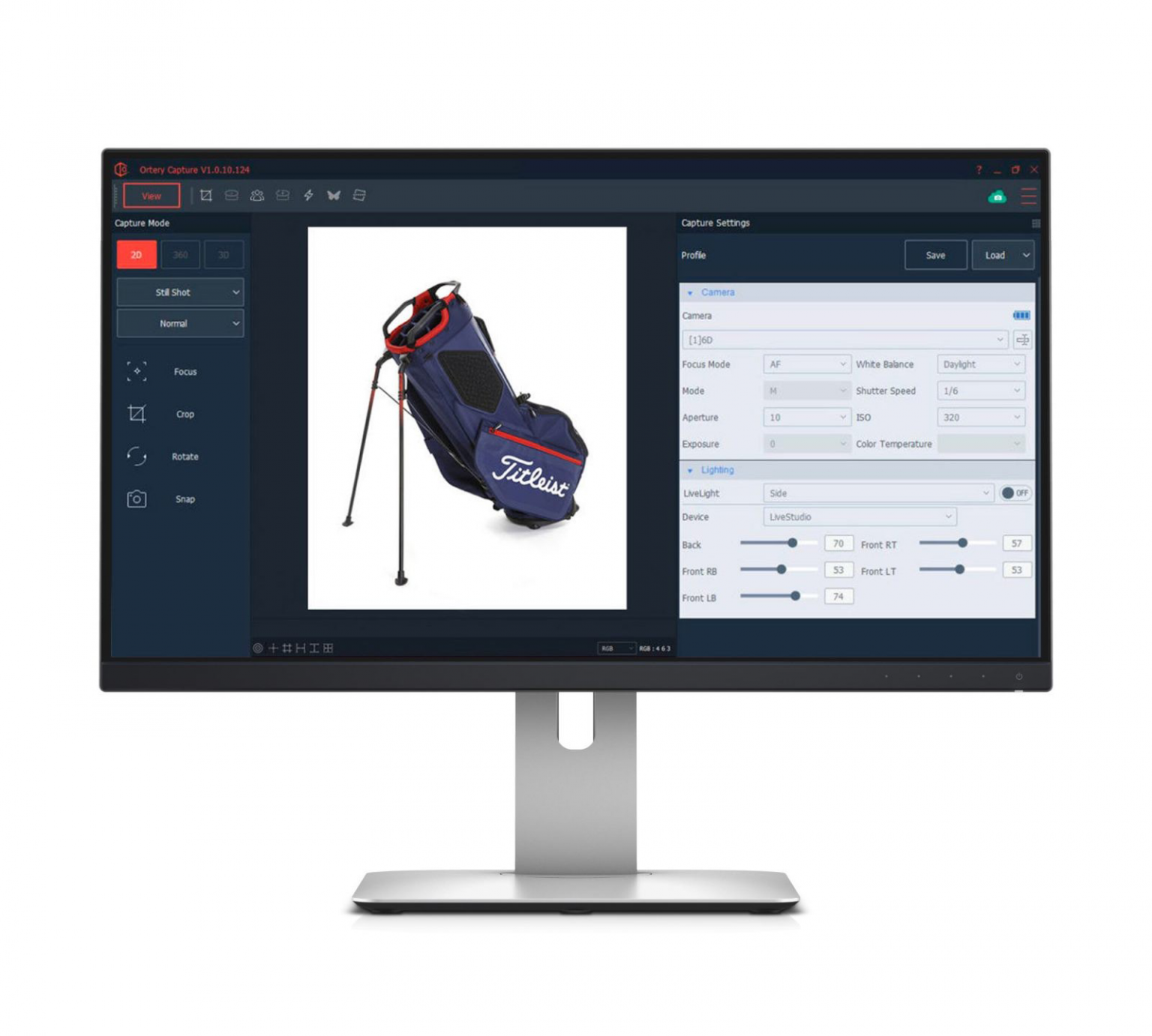ECommerce photography is changing, with more pressure and less budget but there are great rewards to be had. Richard Harvey from Canon UK, Duncan Taylor of EME Digital and Sam Shearer, MD of Ortery Inc, discuss…
First, some facts. “Ten years ago, around 12 percent of retail sales were online. Today it’s about 30 percent. The importance of the online channel is greater, but the content production budgets haven’t grown at anything like the same rate,” Duncan Taylor, MD of EME Digital, explains. “For the people charged with enabling that growth, it has been a story of delivering more for less: more content needed at higher quality, produced more quickly, for less money.”
He continues: “Many companies have brought production in-house. Outsourced eCom photography still exists but the trend has been to bring it in-house. Only the high-profile shoots get the full agency or a sub-contracted photographer these days; regular eCommerce production is handled at the office or perhaps in a part of the warehouse.”
Content is changing
“The pendulum may be swinging back to lifestyle photos,” Sam Shearer, MD of Ortery Inc, predicts, “but in a different way, where consumers circle what they want and make immediate purchases on the platform that showed them the picture.
“But there is more junk content out there than ever before,” he cautions. “The spoils will still go to the companies that have the relationships and ability to show the product in a professional manner. Influencers will not want to pass off their leads to companies showing ugly product shots…”
Has video become an important element in the creative mix? According to Canon UK’s Richard Harvey: “Definitely. People want to see how a dress moves, how the folds are, what happens when you sit down in those trousers, what’s the sound of a handbag being opened? What does it sound like when you close a car door? Audio, video and stills: it’s all coming together, and the next step will be virtual, with AI content increasingly helping and enhancing.”
“Video has grown enormously,” Duncan confirms, “Short form especially. It being so simple to switch a high-quality stills camera to a high-quality video camera. That is echoed by the photographer switching to the videographer. Plus, it’s easier and cheaper to host and incorporate video nowadays.
Source: Amazon Video Production, eme Digital
He continues: “The other major area of change over the past ten years is imaging technology – AR, Photogrammetry, Virtual Production and LED Stages and most significantly AI. The people who drive many of these projects are more likely to be technically able rather than creative photographers. And there can be pain in that.”
This is where a partnership can really help. Richard was a photographer before joining Canon UK 20 years ago. And now, in his current role, he visits retailers to advise staff on equipment set-ups, best practice and even styling.
“Generally, my role involves product training to help staff achieve a good knowledge of the equipment,” he explains. And if you needed a reason to use Canon it’s colour. Getting that bit right is essential, because that’s the backbone of eCom. If your orange dress doesn’t match your orange handbag, it gets sent back.”
Duncan agrees, adding: “The sheer volume required these days also presents problems. There’s frequently such a huge amount of stock to be photographed and retouched in such a short time, that the basics need to be right straight away, like colour fidelity. Without that worry you can work on the other challenges, usually volume. A thousand products per day needed online within a two-day deadline as an example.”
Simple eCom set-ups that work
“The typical eCommerce photography set-up for smaller products used to be a product table, with manually adjusted lighting and one hand-held or tripod mounted camera,” Duncan remembers. “The product would be styled and lit, images shot to card, then card to Photoshop where background would be moved, image re-sized, re-touched, named and uploaded to storage. It was a multi-stage process, sometimes undertaken by one skilled and knowledgeable photographer and sometimes the tasks split between a team of specialists.” Many would argue that was a clunky process, and not efficient from a business point-of-view.
Duncan continues: “The introduction of photography automation systems makes the process repeatable and de-skill it to a one-man job. The camera or cameras are software controlled now so their settings can be recalled, the lighting is software controlled too, so the same configuration and can be set with just one click, while saving and editing is programmed so the same things happen to the images automatically, including high quality background removal and addition.
“Most people will have seen the boxed systems. These come in various sizes and are capable of handling a variety of items and even live models. All have the lighting built-in, and all are software controlled while many have a turntable to automate product positioning or create 360-degree presentations in video or from a sequence of still shots. Some even have one camera sliding along a 90-degree rail whilst others use one top-down and one side-view camera and one hand-held for close-up.”
Software for success
The high-pressure world of fashion retail owes much to the efficiency of the equipment and the software behind-the-scenes is equally important to help bring catalogues to life with enticing images of the latest styles and trends.
The images created of clothes and accessories all shot on clean white backgrounds and beautifully lit are the staple of the industry and Canon’s SDK is one of the driving forces behind this success.
“I was privy to the launch of the Canon software development kit,” Richard recalls. One of the real revolutions in this business. It’s only via that crucial software and automation that the combination of lighting environment, camera control, image editing and porting can be made and synchronized into one process.”
Canon has invested heavily in offering customers the most cost-effective and flexible route to high-quality eCom photography.
The EOS Digital Software Developer Kit (EDSDK) allows users to control Canon cameras remotely from a Windows or Mac PC and use the same code across all compatible Canon cameras. And for bigger set-ups, to take advantage of multi-platform support on select models for faster workflows, Canon’s Camera Control API (CCAPI) spans multiple platforms, allowing wireless usage in any environment, such as Windows, Mac, Android, iOS or Linux.

Identifying the problems
Sam Shearer comments: “Before purchasing online, people need confidence that what they see is what they will get. ECommerce listings are showing more shots from more angles than ever before, with still product shots bolstered with interactive 360 and 3D product views to give the consumer more information. Traditional methods for capturing high-quality images, videos, and interactive 360/3D content are time-consuming.”
Five main pain points for creative content these days are:
- Scaling visual content production without sacrificing quality.
- Create professional visuals across a wide range of products and locations with consistent image quality.
- Budgets not keeping up with increased demand for content.
- Limited in-house technical expertise.
- High volumes of product content without good software.
Monitoring current trends
Sam continues: “Manufacturers are getting smarter at using the voice of the end user to sell products, too, so now there’s high-quality audio to consider. Again, another demand. The need to accurately portray your products will remain paramount, so more pictures from more angles, but video is the easiest way to tell a story and connect with customers.
“While software and integration can speed up time to market and can provide amazing analytics, a good picture is still at the heart of making a sale,” Sam comments. “People can quickly take a picture and have software remove the background and pop it on to a website, but the main point of a good picture is whether its capable of producing a sale.

“And as new technologies arrive, you cannot escape the fact that to make good photographic or video content you must have lighting that is capable of showing the product and its characteristics in a flattering way and a camera system capable of realistically capturing the scene. The idea that virtual photography or 3D rendering will eliminate the need for a camera and lighting is yet to be seen.”
Richard Harvey agrees and concludes: “Shopper habits are changing, and they are much more tech savvy than they were ten years ago. And 5G has helped to drive the need for a better online experience as well. People being able to view video on their handheld device, whatever it might be, is just one example. And that’s only going to get quicker and quicker as well. So, it’s an ever-evolving space and being creative is just one part of the workflow, but it’s at the peak of the pyramid. Content quality has to be absolutely right, otherwise everything else just falls over.”
Published 14.04.25


